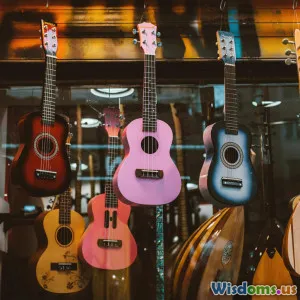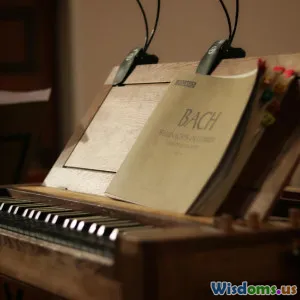
How Ancient Instruments Inspire Modern Music Technology Today
8 min read Discover how ancient musical instruments shape today’s innovative music technology and sound design. (0 Reviews)
How Ancient Instruments Inspire Modern Music Technology Today
Introduction
Humanity’s relationship with music spans millennia, with ancient instruments transmitting stories, traditions, and emotions long before the advent of electronic consoles and digital audio workstations. Though separated by centuries, the echoes of these primordial sounds still vibrate in modern music technology, significantly influencing how artists and engineers create new sounds and compositions today.
What’s fascinating is how ancient instruments—crafted with raw materials like wood, bone, and metal—have transcended time to inspire contemporary electronic instruments, digital interfaces, and sound synthesis techniques. This article explores the rich interplay between traditional instrument design philosophies and modern music tech innovations.
The Legacy of Ancient Instruments in Modern Sound Design
1. Timbre and Acoustic Principles
Many ancient instruments are lauded for their unique timbres, derived from their materials and construction techniques. For instance, the Theremin, invented in 1920 but inspired by early electronic ideas, has a haunting sound that echoes the ethereal tones found in ancient string and wind instruments such as the erhu or didgeridoo.
Engineers designing synthesizers and samplers often analyze these natural acoustic properties. The Tibetan singing bowls, used for centuries in meditation with their powerful harmonic overtones, have influenced granular synthesis techniques to emulate their rich resonances digitally. Similarly, the modal scales from ancient Middle Eastern instruments feed into modern sound libraries and scales used in electronic music production.
2. Instrument Interfaces Inspired by Tools of Antiquity
Modern music technology increasingly pursues intuitive interfaces that physically engage musicians beyond simple keyboard triggers. The hang drum, a recent innovation with ancient steelpan origins, inspires controllers that allow nuanced hand gestures to modulate sound dynamically.
Moreover, developments like the Roli Seaboard keyboard, which enables expressive touch, draw conceptual parallels to ancient fretless instruments like the veena or oud, where subtle finger movements alter pitch and vibrato—traits crucial for modal music systems worldwide.
3. Microtonality and Scale Systems
Unlike Western music’s rigid 12-tone equal temperament, many ancient instruments inherently embraced microtonal scales. Early Mesopotamian lyres, Indian sitars, and Japanese shamisen utilize continuous pitch variations, intervals smaller than a semitone, enriching the musical palette.
Contemporary software synthesizers and virtual instruments increasingly incorporate microtonal capabilities, allowing musicians to explore these ancient tonal possibilities. Native Instruments’ Komplete suite, for example, offers microtonal tuning options, enabling the fusion of traditional scales with modern electronic textures, expanding sonic creativity.
Real-World Examples of Ancient Influence in Music Technology
The Influence of the Kalimba and Thumb Piano
Originating centuries ago in Africa, the kalimba or thumb piano is an instrument with a wooden board and metal tines played by plucking with thumbs. This simplistic yet sonically complex instrument influenced digital apps and plugins that simulate its percussive melodic sounds.
Apps like ‘TonalEnergy’ use kalimba’s tuning logic to help musicians practice pitch recognition and rhythm. On a hardware level, engineers design MIDI controllers inspired by kalimbas, featuring metal keys that respond to pressure and velocity analogous to the wooden-finger contact.
The Didgeridoo’s Drone and Sound Synthesis
The Australian Aboriginal didgeridoo produces deep, resonant drones accompanied by complex overtones and rhythmic breathing techniques. Modern synthesizers emulate these drones through wave shaping and filtering methods inspired by didgeridoo acoustics, integrating breath controllers to mimic airflow dynamics.
Wind instrument makers have employed sensors detecting changes in breath pressure for electronic didgeridoos or similar controllers, enabling musicians to summon rich, organic sounds while harnessing digital flexibility.
Ancient Mechanical Concepts Fueling Modern Innovation
Mechanical instruments like the water organ, hurdy-gurdy, and barrel organs utilized mechanical automation centuries ago. Contemporary music technology borrows from these ideas when creating algorithmic composition tools and mechanical breath controllers.
For example, the LinnDrum machine references the principles of controlled mechanical strikes akin to ancient automatons. Additionally, the growing field of robotic musical instruments, such as the Teatro Alla Scala’s automated pipe organ, channel early mechanical music ideas into the digital age.
Experts’ Insights: Bridging Past and Future
Dr. Elaine Mitchener, a composer integrating ancient string instrument sounds into electroacoustic performance, notes, "The tactile, organic qualities of ancient instruments remind us that music technology must retain human expression and nuance, despite the rise of digital abstraction."
Likewise, synthesizer pioneer Dr. Wendy Carlos highlighted the importance of historical tuning practices: "Revisiting ancient scale systems reveals much about emotional and psychological effects of tuning. Today's technology offers unprecedented fidelity to realize such subtle tonalities."
Their insights underscore an evolving understanding that technology should augment, not replace, the emotive force rooted in time-honored musics.
Conclusion
As technology hurtles forward, continuously shifting how music is produced and perceived, the enduring wisdom of ancient instruments remains invaluable. They embody centuries of experimentation with sound, craftsmanship, and culture—offering textures, tunings, and mechanical principles that modern music technology increasingly embraces.
From microtonal synths and expressive controllers inspired by fretless strings to digital recreations of rare acoustic timbres, there is a rich, reciprocal relationship between ancient sounds and contemporary electronic innovation. Musicians and engineers who study this lineage gain not only new sonic tools but also a profound appreciation for music’s cultural heritage.
The future of music technology, it appears, is profoundly tethered to the wisdom etched in the strings, reeds, and shells of our ancestors’ instruments. By bridging historic craftsmanship with cutting-edge design, the music community ensures that the past’s sonic innovations continue to spark creativity and emotional connection for generations to come.
Rate the Post
User Reviews
Popular Posts


















